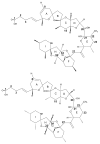Azaspiracid shellfish poisoning: a review on the chemistry, ecology, and toxicology with an emphasis on human health impacts
- PMID: 18728760
- PMCID: PMC2525481
- DOI: 10.3390/md20080004
Azaspiracid shellfish poisoning: a review on the chemistry, ecology, and toxicology with an emphasis on human health impacts
Abstract
Azaspiracids (AZA) are polyether marine toxins that accumulate in various shellfish species and have been associated with severe gastrointestinal human intoxications since 1995. This toxin class has since been reported from several countries, including Morocco and much of western Europe. A regulatory limit of 160 microg AZA/kg whole shellfish flesh was established by the EU in order to protect human health; however, in some cases, AZA concentrations far exceed the action level. Herein we discuss recent advances on the chemistry of various AZA analogs, review the ecology of AZAs, including the putative progenitor algal species, collectively interpret the in vitro and in vivo data on the toxicology of AZAs relating to human health issues, and outline the European legislature associated with AZAs.
Keywords: AZP; azaspiracid (AZA); shellfish poisoning.
Figures



References
-
- Satake M, Ofuji K, James KJ, Furey A, Yasumoto T. New toxic event caused by Irish mussels. In: Reguera B, Blanco J, Fernandez ML, Wyatt T, editors. Harmful Algae. Santiago de Compostela; Xunta de Galicia and Intergovernmental Oceanographic Commission of UNESCO: 1998. pp. 468–469.
-
- Satake M, Ofuji K, Naoki H, James KJ, Furey A, McMahon T, Silke J, Yasumoto T. Azaspiracid, a new marine toxin having unique spiro ring assemlies, isolated from Irish mussels, Mytilus edulis. J Amer Chem Soc. 1998;120:9967–9968.
-
- Anon . Food Safety Authority of Ireland (FSAI); Abbey Court, Lower Abbey Street, Dublin 1, Ireland: 2006. Risk Assessment of Azaspiracids (AZAs) in Shellfish, August 2006 - A Report of the Scientific Committee of the Food Safety Authority of Ireland (FSAI)
-
- Taleb H, Vale P, Amanhir R, Benhadouch A, Sagou R, Chafik A. First detection of azaspiracids in mussels in north west Africa. J Shellfish Res. 2006;25:1067–1070.
-
- Nicolaou KC, Koftis TV, Vyskocil S, Petrovic G, Tang W, Frederick MO, Chen DYK, Yiwei L, Ling T, Yamada TMA. Total synthesis and structural elucidation of azaspiracid-1. Final assigment and total synthesis of the correct structure of azaspiracid-1. J Am Chem Soc. 2004;128:2859–2872. - PubMed
Publication types
MeSH terms
Substances
LinkOut - more resources
Full Text Sources
